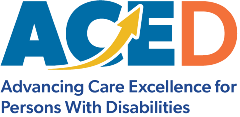Communicating with Persons with Disabilities Teaching Strategy
People with disability often report that health care professionals treat them differently or do not communicate with them about their disability. Some may be uncomfortable discussing it, while others may think that since the disability is “old” or not the primary problem, it is not relevant to the care of the person.
The communication module is designed to promote effective communication of nursing students who will interact with persons with disability during the course of their clinical experience(s). The module is a teaching strategy that addresses overarching issues related to communication with persons with disability during any and all clinical settings and situations.
It is designed to be used by nursing faculty in a classroom setting at any point during the nursing curriculum. Since effective communication skills are usually introduced early in the nursing curriculum, use of the module and integration with other communication teaching strategies is recommended.
Communicating with Persons with Disabilities
Download All Files for This Teaching Strategy
Learning Objectives
Students will:
- Identify effective and ineffective communication strategies with individuals with disabilities as demonstrated in the communication videos.
- Assess personal communication skills and level of comfort in interacting with persons with disabilities.
- Discuss effective communication strategies to be used when assessing a patient with a disability for other aspects of their health and health care.
- Recognize the importance of acknowledging the person’s disability, even if it is not the primary problem at the time of the interaction.
Learner Prework
- Why Disability Matters
- Disability Overview
- Brief History of Disability
- Communicating with Persons with Disabilities
- Definition of Terms
Suggested Learning Activities
Have the class watch the video together.
- Have students form groups of 6-8 per group. Then have students work in assigned groups to discuss the video (ineffective communication). It is best not to identify the communication as ineffective to the students.
- Instruct students in each of the groups to respond to the questions below (15 minutes):
-What did the nurse do well in the interaction with Kate? Provide evidence from your classroom work and readings to support your observations.
-What could the nurse have done differently to improve the interaction with Kate? Provide evidence from your classroom work and readings to support your recommendations.
-Take 3 or 4 statements that the nurse used in her communication with Kate and reword them to make the communication more therapeutic.
-What did the nurse do correctly with the SBAR and what could the nurse have done differently with the SBAR? Provide evidence from your classwork and readings to support your responses.
-Describe how you would feel if you were Kate. Based on this interaction, what effect do you think it might have on Kate's perceptions about nurses and the health care system? What is the likely effect of this experience on her future interactions with the health care system? (Every group should answer this)
Communication Video # 2 (Effective Communication). Have the class watch this video together.
- Have students work in assigned groups to discuss the video (Effective Communication). Without identifying the communication as effective, instruct the student group to respond to the same questions as above, and then discuss their responses.
Communication Video # 3. Have students watch the personal interview between Suzanne Smeltzer, and Kate, the standardized patient with a disability, who is the patient in Communication Videos #1 and #2.
Author Information
Villanova University
Villanova, PA


